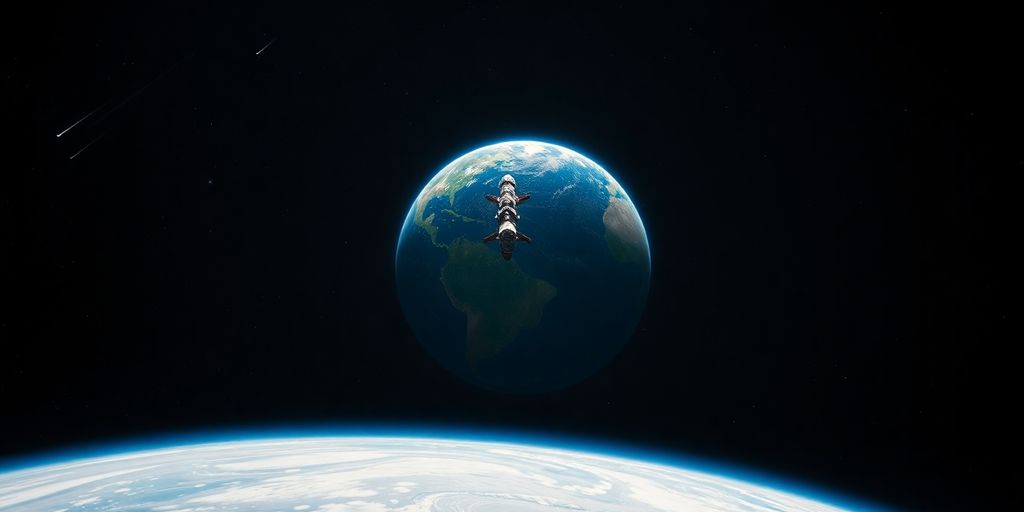Have you ever wondered how long it takes to get to space? The answer isn’t as straightforward as you might think. To understand this journey, we first need to define what ‘space’ actually is, and then explore the different ways we can reach it. From rockets to spacecraft, the time it takes can vary significantly depending on the vehicle and mission parameters. Let’s break down the journey beyond our planet and see just how long it takes to reach the final frontier.
Key Takeaways
-
The Kármán Line, located at 100 km (62 miles) above sea level, marks the boundary of space.
-
NASA’s Space Shuttle could reach orbit in about 8.5 minutes, showcasing the speed of modern spacecraft.
-
Traveling to the International Space Station can take anywhere from 4 hours to 3 days, depending on the spacecraft used.
-
Historical milestones, like Yuri Gagarin’s flight in 1961, highlight the rapid advancements in space travel.
-
Future technologies may significantly reduce travel times, especially for commercial space travel.
Defining The Boundary Of Space
Okay, so before we even start talking about how long it takes to get to space, we need to figure out where space actually begins. It’s not like there’s a big sign up there, right? It’s more of a gradual fade from our atmosphere into, well, nothingness. But for the sake of space travel and setting records, we need a clear definition.
Understanding The Kármán Line
The Kármán Line is generally accepted as the boundary between Earth’s atmosphere and outer space. It’s an imaginary line sitting 100 kilometers (62 miles) above mean sea level. Why 100 km? Well, it’s the altitude where, theoretically, a vehicle would need to travel faster than orbital speed to generate enough aerodynamic lift to stay in the air. Basically, any lower and it’s still considered flight; any higher, and it’s space.
Altitude And Its Significance
Altitude plays a huge role in space travel. The higher you go, the thinner the atmosphere gets. This means less drag on spacecraft, which is good for speed and fuel efficiency. Plus, different altitudes are used for different purposes. For example, Low Earth Orbit (LEO), where the International Space Station hangs out, is typically between 160 km and 1,000 km. Understanding altitude is key to understanding spacecraft launches and mission planning.
The Transition From Atmosphere To Space
It’s not like you hit the Kármán Line and suddenly float weightlessly. The transition from atmosphere to space is gradual. As you ascend, the air gets thinner and thinner, and the effects of gravity slowly decrease. There’s no hard border, but the Kármán Line gives us a practical way to define when we’ve officially left Earth’s atmosphere. It’s more of a legal and operational boundary than a physical one.
Think of it like this: the atmosphere doesn’t just end; it fades. The Kármán Line is just a convenient marker we’ve agreed upon to say, “Okay, past this point, you’re in space.”
Here’s a simple breakdown:
-
Troposphere: Where we live and where weather happens.
-
Stratosphere: Home to the ozone layer.
-
Mesosphere: Where meteors burn up.
-
Thermosphere: Contains the Kármán Line and LEO.
-
Exosphere: The outermost layer, gradually fading into space.
The Journey To Space
Time Taken By Different Vehicles
Okay, so you want to know how long it takes to get to space? It’s not a simple answer, because it really depends on what we’re talking about. For example, a suborbital flight, like those done by Virgin Galactic, are way different than a trip to the International Space Station. Suborbital flights might only take a few minutes to reach the edge of space, while getting to the ISS can take several hours. Different vehicles have different capabilities, which directly impacts travel time.
-
Suborbital flights: Minutes
-
ISS missions: Hours
-
Missions to the Moon: Days
Factors Affecting Travel Time
There are a bunch of things that can change how long it takes to get to space. The type of rocket, the trajectory, and even the weather all play a role. A more powerful rocket can obviously get you there faster. The path you take – a direct route versus one that uses gravity assists – also matters. And of course, you can’t ignore the weather; a launch can be delayed if conditions aren’t right. It’s a complex equation with many variables. Understanding these factors affecting travel time is key to planning any space mission.
The amount of fuel a spacecraft carries is a major factor. More fuel means more acceleration, but also more weight. It’s a balancing act that engineers have to carefully consider.
Comparison Of Spacecraft Speeds
Spacecraft speeds are mind-boggling. The Space Shuttle, for instance, traveled at around 17,500 miles per hour to stay in orbit. That’s incredibly fast! But even that pales in comparison to probes like Voyager 1, which has been traveling for decades and is now moving at speeds that allow it to escape our solar system. Here’s a quick look at some typical speeds:
|
Spacecraft |
Approximate Speed (mph) |
|---|---|
|
Space Shuttle |
17,500 |
|
Voyager 1 |
38,000+ |
|
Apollo Missions |
25,000 |
It’s wild to think about how fast these things are moving. The speed of spacecraft is a testament to human engineering and our desire to explore the cosmos.
Historical Milestones In Space Travel
First Human In Space
Wow, thinking about the first person to ever leave Earth just blows my mind. Yuri Gagarin, a Soviet cosmonaut, holds that incredible honor. On April 12, 1961, he blasted off in the Vostok 1 spacecraft. It only took about 10 minutes to reach an altitude of 327 km (203 miles). Can you imagine the courage it took to be strapped into that rocket, not knowing what was on the other side? It’s a moment that changed everything.
Notable Space Missions
There have been so many missions that have pushed the boundaries of what we thought was possible. The Voyager missions are a great example. Voyager 1, for instance, is now the most distant human-made object, and it took 36 years to reach the edge of interstellar space. That’s a long trip! And then there’s the Space Shuttle program, which really advanced our understanding of reusable spacecraft. It’s amazing to see how far we’ve come.
Evolution Of Spacecraft Technology
It’s wild to think about how much spacecraft technology has changed over the years. From those early capsules to the sophisticated spacecraft we have today, it’s been a rapid evolution.
The advancements in materials, propulsion systems, and onboard computers have been game-changers. We’ve gone from basic rockets to spacecraft capable of complex maneuvers and long-duration missions. It makes you wonder what the next generation of spacecraft will look like.
Here’s a quick look at some key milestones:
-
Early capsules (Vostok, Mercury)
-
Reusable spacecraft (Space Shuttle)
-
Long-duration spacecraft (Voyager)
-
Modern multi-purpose spacecraft (Dragon, Orion)
Reaching The International Space Station
Getting to the International Space Station (ISS) isn’t a quick trip down the street. It’s a carefully orchestrated journey that can vary quite a bit.
Travel Time Variations
The time it takes to reach the ISS isn’t set in stone. It can range from a speedy four hours to a more drawn-out three days. What causes this difference? Well, it boils down to a few key things. The type of spacecraft being used plays a big role, as do the specific objectives of the mission. Some missions require a more direct and faster route, while others might take a more gradual approach to conserve fuel or conduct additional experiments along the way. It’s all about finding the right balance between speed and efficiency. For example, a quick trip to the ISS is always preferred.
Different Spacecraft Capabilities
Not all spacecraft are created equal. Some are designed for speed and efficiency, while others prioritize cargo capacity or other features. The Russian Soyuz spacecraft, for instance, has a long history of reliably transporting astronauts to the ISS. More recently, spacecraft like SpaceX’s Crew Dragon have also joined the ranks, offering their own unique capabilities and approaches to reaching the station. Each spacecraft has its own trajectory and propulsion systems, which directly impact the travel time. It’s like comparing a sports car to a грузовик; both can get you there, but they’ll do it in very different ways.
Mission Parameters Impacting Duration
Beyond the spacecraft itself, the specific parameters of the mission also play a significant role in determining how long it takes to reach the ISS. Things like the launch window, the orbital alignment of the Earth and the ISS, and any planned maneuvers along the way can all add time to the journey. It’s a bit like planning a road trip; you need to consider the traffic, the route, and any stops you want to make along the way. The more complex the mission, the longer it’s likely to take.
Getting to the ISS is a complex dance of engineering, physics, and careful planning. It’s a testament to human ingenuity that we can even accomplish such a feat, and I’m constantly amazed by the dedication and skill of the people who make it happen. The International Space Station is a marvel of engineering.
Future Of Space Travel
Advancements In Spacecraft Technology
I’m really excited about what’s coming next in spacecraft tech. We’re talking about stuff that sounds like science fiction, but it’s getting closer to reality every day. Think about ion propulsion systems that could drastically cut down travel times, or even fusion-powered rockets that could take us to Mars in a matter of weeks. These aren’t just incremental improvements; they’re game-changers that could redefine space travel. I’m also keeping an eye on the development of more efficient and reusable spacecraft, which will lower the cost of launches and make space more accessible.
Potential For Faster Travel
The biggest hurdle in space travel right now is time. Getting anywhere takes ages, and that’s a major limitation. But there’s a lot of research going into ways to speed things up. One promising area is the development of advanced propulsion systems, like I mentioned before. Another is exploring the possibility of using solar sails to harness the power of the sun for propulsion. And then there are the more far-out ideas, like warp drives and wormholes, which are still largely theoretical but could revolutionize space travel if they ever become feasible.
Commercial Space Travel Prospects
Commercial space travel is no longer a thing of the future; it’s happening right now. Companies like SpaceX and Blue Origin are already sending tourists to space, and that’s just the beginning. I think we’re going to see a huge expansion of commercial space activities in the coming years, with everything from space tourism to orbital manufacturing becoming commonplace. This will not only make space more accessible to ordinary people but also drive innovation and create new opportunities for economic growth. It’s a really exciting time to be alive, seeing the dawn of a new era of space exploration.
I believe that the future of space travel is bright. With continued investment in research and development, and the rise of commercial space activities, we’re on the cusp of a new golden age of space exploration. The possibilities are endless, and I can’t wait to see what the next few decades bring.
Understanding Spacecraft Launches
Launch Windows And Their Importance
Getting a spacecraft off the ground isn’t as simple as just pointing it up and hitting a button. There’s a lot of planning involved, and one of the most important aspects is figuring out the launch window. A launch window is a specific period of time when conditions are optimal for launching a spacecraft to reach its intended destination. These windows depend on a bunch of factors, like the positions of Earth, the target planet (if it’s going somewhere else), and the amount of fuel needed. If you miss the window, you might have to wait days, weeks, or even years for the next one, which can really mess up a mission’s schedule and budget.
Preparation For Launch
Before any rocket roars to life, there’s a ton of work that goes on behind the scenes. It’s not just fueling up and hoping for the best. Here’s a glimpse of what I think happens:
-
Vehicle Assembly: The rocket and spacecraft are put together, which is like assembling a giant, super-complicated Lego set.
-
Testing, Testing, Testing: Every system gets checked and re-checked. We’re talking engines, navigation, communication – everything. If something’s off, it gets fixed. No shortcuts.
-
Payload Integration: The satellite, probe, or whatever the rocket is carrying gets carefully installed. This has to be done with extreme precision to avoid any damage.
-
Final Checkouts: In the days leading up to launch, there are more tests, simulations, and reviews to make sure everything is go for launch. It’s a tense time for everyone involved.
The whole process is incredibly complex, involving thousands of people and countless hours of work. It’s a testament to human ingenuity and dedication.
The Role Of Ground Control
Ground control is the unsung hero of every space mission. These are the people who monitor the spacecraft before, during, and after launch. They’re the ones who send commands, receive data, and make sure everything is running smoothly. They are in charge of mission parameters. During launch, they keep a close eye on the rocket’s trajectory, speed, and overall health. If something goes wrong, they’re the ones who have to make split-second decisions to correct the course or, in the worst-case scenario, abort the mission. Even after the spacecraft is in orbit, ground control continues to play a vital role, ensuring that it stays on course and performs its intended functions. They are the link between Earth and space, and without them, space travel wouldn’t be possible.
The Experience Of Astronauts
Training For Space Missions
As an astronaut, my training is intense and varied. It’s not just about knowing the science; it’s about being able to handle anything that space throws at you. We spend countless hours in simulators, practicing everything from routine operations to emergency scenarios. Survival training is a big part of it, too. We learn how to deal with extreme environments, from underwater simulations mimicking weightlessness to desert survival skills. It’s all about preparing us for the unexpected, because in space, anything can happen. The goal is to make every possible situation second nature.
Life In Space
Living in space is a unique experience, to say the least. Simple things become complicated, like eating or sleeping. Everything floats, so you have to be careful with your food and equipment. We use special sleeping bags that attach to the wall to keep us from drifting around the cabin. Exercise is critical to combat muscle loss and bone density reduction in zero gravity. We spend a couple of hours each day working out on a treadmill or stationary bike. It’s also important to maintain a connection with Earth. We have regular video calls with our families and friends, which helps us stay grounded during long missions.
Challenges Faced During Travel
Space travel presents a unique set of challenges. Radiation exposure is a constant concern, and we take precautions to minimize our risk. The psychological effects of isolation and confinement can also be tough. We work closely with psychologists and counselors to manage stress and maintain our mental well-being. And then there’s the physical toll. The human body isn’t designed for space, and we experience a range of symptoms, from motion sickness to bone loss. Despite these challenges, the opportunity to explore the cosmos makes it all worthwhile.
One of the biggest adjustments is the lack of gravity. It affects everything from how we move to how our bodies function. It takes time to adapt, but eventually, you get used to it. The view of Earth from space is something you never get used to, though. It’s a constant reminder of the beauty and fragility of our planet.
Wrapping Up the Journey to Space
So, how long does it really take to get to space? Well, it can be as quick as 8 minutes if you’re on a rocket like the Space Shuttle. But if you’re thinking about walking, you’d be looking at over 16 hours! It all depends on how you’re getting there. The journey to the International Space Station can take anywhere from a few hours to a couple of days, depending on the mission. Space travel is a mix of speed and technology, and it’s fascinating to see how far we’ve come since Yuri Gagarin first went up in 1961. Whether you’re dreaming of being an astronaut or just curious, understanding the time it takes to reach space gives us a glimpse into the incredible adventures that await beyond our planet.
Frequently Asked Questions
What is the Kármán Line?
The Kármán Line is the point that marks the boundary between Earth’s atmosphere and outer space. It is located about 100 kilometers (62 miles) above sea level.
How long does it take to reach space?
Using a rocket, it usually takes about 8 to 10 minutes to reach space, while other methods like walking or driving would take much longer.
What factors affect how long it takes to get to space?
The time it takes to get to space can depend on the type of spacecraft, its speed, and the mission goals.
How fast do spacecraft travel?
Spacecraft can travel at different speeds. For example, the Space Shuttle traveled at around 28,000 kilometers per hour (17,500 miles per hour) to reach orbit.
How long does it take to get to the International Space Station?
It can take anywhere from 4 hours to 3 days to reach the International Space Station, depending on the spacecraft and mission plan.
What challenges do astronauts face during space travel?
Astronauts deal with many challenges in space, like weightlessness, limited supplies, and the need for special training to handle emergencies.




